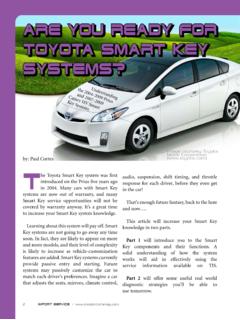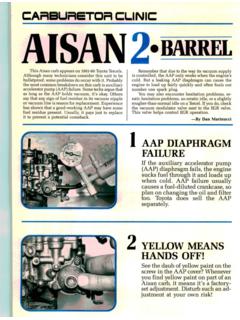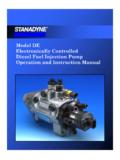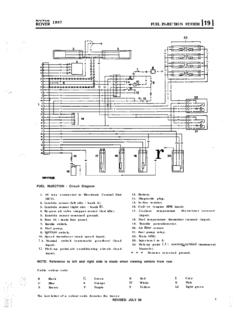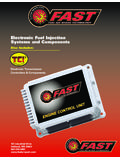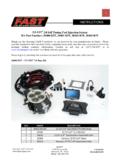Transcription of 1988-1991 Honda Civic DualPoint Fuel Injection
1 24 May 2000 Dual Point fuel Injection means two fuel injectors. The injector mixer, or throttle body, houses the injectors. This may looklike a carbureted model, especially if youremove the lid from the helmet on top of the throt-tle body and see what appears to be a choke butterfly. This butterfly has a curved cutout onthe valve cover side to force air to acceleratethrough it as it passes in front of the main injectorat slow speed or cruise conditions. This providesfor better fuel atomization. At wide open throttle, there is a vacuumdiaphragm that uses ported vacuum to open thevalve fully to increase airflow. The two injectorsare on the front, or valve cover side of the throttlebody.
2 The auxiliary fuel injector is at the base ofthe throttle body, below the throttle blade. Thisinjector uses a green plastic connector. The maininjector is above it, right under the helmet, with abrown plastic connector. Auxiliary InjectorThe auxiliary injector sits under the throttle blade and fires all the time. It s the only injectorpulsed at idle. Because it sits below the throttleblade, it is exposed to manifold vacuum at all Point fuel Injection Last month we examined the behav-ior of a failed TW sensor on a 1991 Honda Civic . This month we ll add afew more details to the diagnosis,and explain the other componentsthat make this system tick.
3 How dothe injectors and main relay work?Which injectors fire when? And what about that alternator control? We ll give you a complete a rundownon the Dual Point fuel injectedengine s system operation, its quirksand several other things you shouldbecome familiar with. Part Two Diagnostic and Repair Tips1988-1991 Honda Civic27 Unlike most throttle body carsyou ll see, it runs the same high-er 36-41 psi fuel pressure as itsmultiport cousin. The yellow/black wire is power from thePGM-FI main relay. The yellowwire goes to the PCM, where it isconnected at two terminals onthe white connector. Main InjectorThe main injector is pulsedwhile cranking, after a coldstartup while the PCM keeps theidle speed up via the ElectronicAir Control valve and at anythrottle opening greater thanidle.
4 This usually means anythrottle value greater than on the TPS. The car willrun if the two injector connec-tors accidentally get swapped,although poorly. If you just gotdone laying sod, you might mixup the injectors , it s green-down,brown-up on this car (refer toPhoto 1, p. 28). The connectorson the harness and the connec-tors on the injectors match whenassembled correctly. Tandem ValveThis is the part that looks likea choke butterfly (refer to Photo2, p. 28). Those guys at Keihinjust couldn t let go of thosewonderful little carburetors!The purpose of the cutout onthe valve cover side is to makeany air traveling into the throttle body confined andaccelerated as it passes the main fuel injector nozzle.
5 Thisdoes wonders for fuel economyduring most driving modes. Asthe throttle is opened further,venturi vacuum acts on thediaphragm on the top rear ofthe throttle body, which con-nects to the tandem it allows greater airflow at wide open throttle. Electronic Load DetectorThe ELD is like having aninductive ammeter in the fusebox (Photo 8, p. 30) to tell thePCM when it s okay to turn offthe alternator to conserve fuelor help an engine catch itsbreath after a cold start. Wiresto the ELD include a black/yel-low wire from the ignitionswitch (12 volts key ON), ablack ground wire and a greenwith red stripe wire that reportsto the PCM.
6 The PCM sends 5volts out on this wire and waitsfor the ELD to do somethingwith it. You may have noticed,particularly if you just installeda new alternator, that the alternator may not start charg-ing right after the engine isstarted. After about one minute,or after turning on an electricalload (headlights or rear defog),the alternator should start to Point fuel InjectionThe tandem valve is visible after the top of the helmet isremoved. Nope, this is not a choke. There is a cutout onthe forward edge of this valve, directly over the main injec-tor. When air passes through this area at modest throttle openings,it really helps that fuel get atomized, thus making for a very fuelefficient is the front of the Dual Point fuel mixer.
7 You can seethe green connector at the base of the mixer for the auxiliary injector, and above it the brown connector forthe main injector. The rubber hose with the spring clamp is thefuel return line and it is attached to the fuel pressure pressure is 36-41 psi. The large rubber hose goesfrom the helmet above the injector where fresh filtered air ismade available to the EACV. If you have a high idle speed thatslows down when this hose blocked, suspect a stuck EACV or aTW sensor commanding the engine to hold the EACV open. If theidle speed drops with the green connector at the EACV unplugged, the TW sensor or ECU is likely at fault. 1To check injector pulse at idle, probe the solid yellowwire either at the injector or at this connector.
8 We re read-ing ms at idle on a clean-running, warmed-upengine. A rich-running engine with a lower pulsewidth may be caused by worn injectors that can t accurately control theamount of fuel sprayed when they open. I ve fixed many Civicsthat have failed an emissions test by installing new injectors are available from Honda in kit above idle the top or main injector reads ms. Probethe solid red wire to obtain your reading. There should beno pulse on this injector at idle. If there is, inspect the baseidle or more important the TPS. The red/blue wire on the TPS mustread less than volts at closed throttle with the engine run-ning.
9 If it doesn t, turn the base idle screw marked with yellowpaint on the passenger side of the mixer, below the throttle cable. 428 May 2000 Dual Point fuel InjectionHose 21 for the MAP sensor is right in the middle of thisphoto. It s the small hose attached to the base of the throt-tle body at a slight angle. The hose often cracks right at itsattaching point. If it does, the MAP value will be higher than normal, and the engine will run very rich. Always compare enginevacuum to your MAP sensor reading if you have these Dual Point fuel system ECU is below the glove boxand under the carpet, on the sloped part of the passengerfloor. When the key is ON, the LED on the side of the ECUshould blink once, then go out.
10 If you get a flashing LED with thekey left ON, you have a fault code stored. 71988 and later Civics have the Electronic Load purposes of fuel savings, and to allow a cold enginea leg up during initial startup, the ECU can turn off thealternator by grounding the C terminal (control) on the alterna-tor connector. When the engine starts, battery voltage will remainat approximately volts for up to one minute as long as thereare no electrical devices being operated. If the headlights areturned on or if the brakes are applied, the alternator should startto charge right away. I have seen cases on Hondas and Acuras where the ECU failedand kept the alternator turned off indefinitely.
